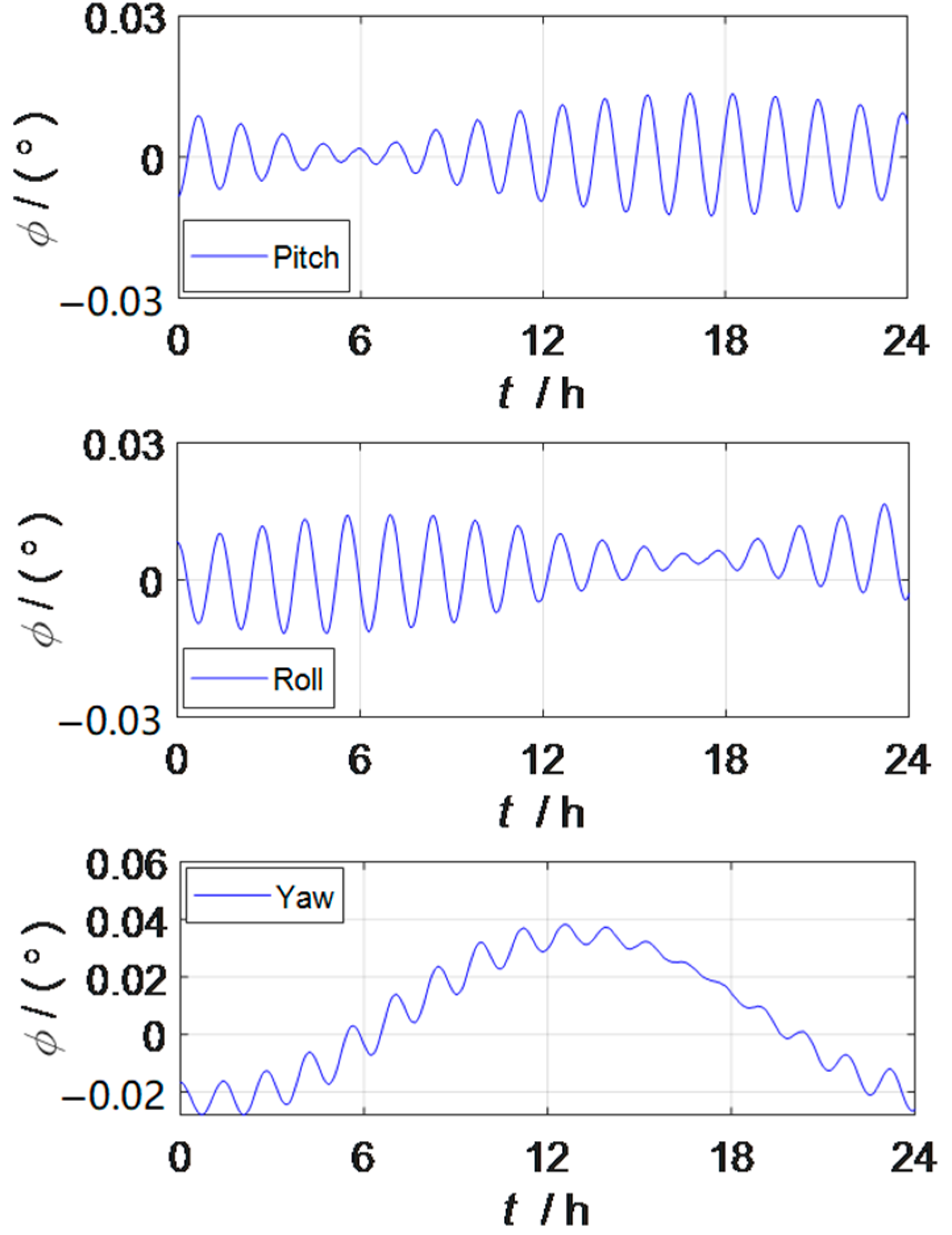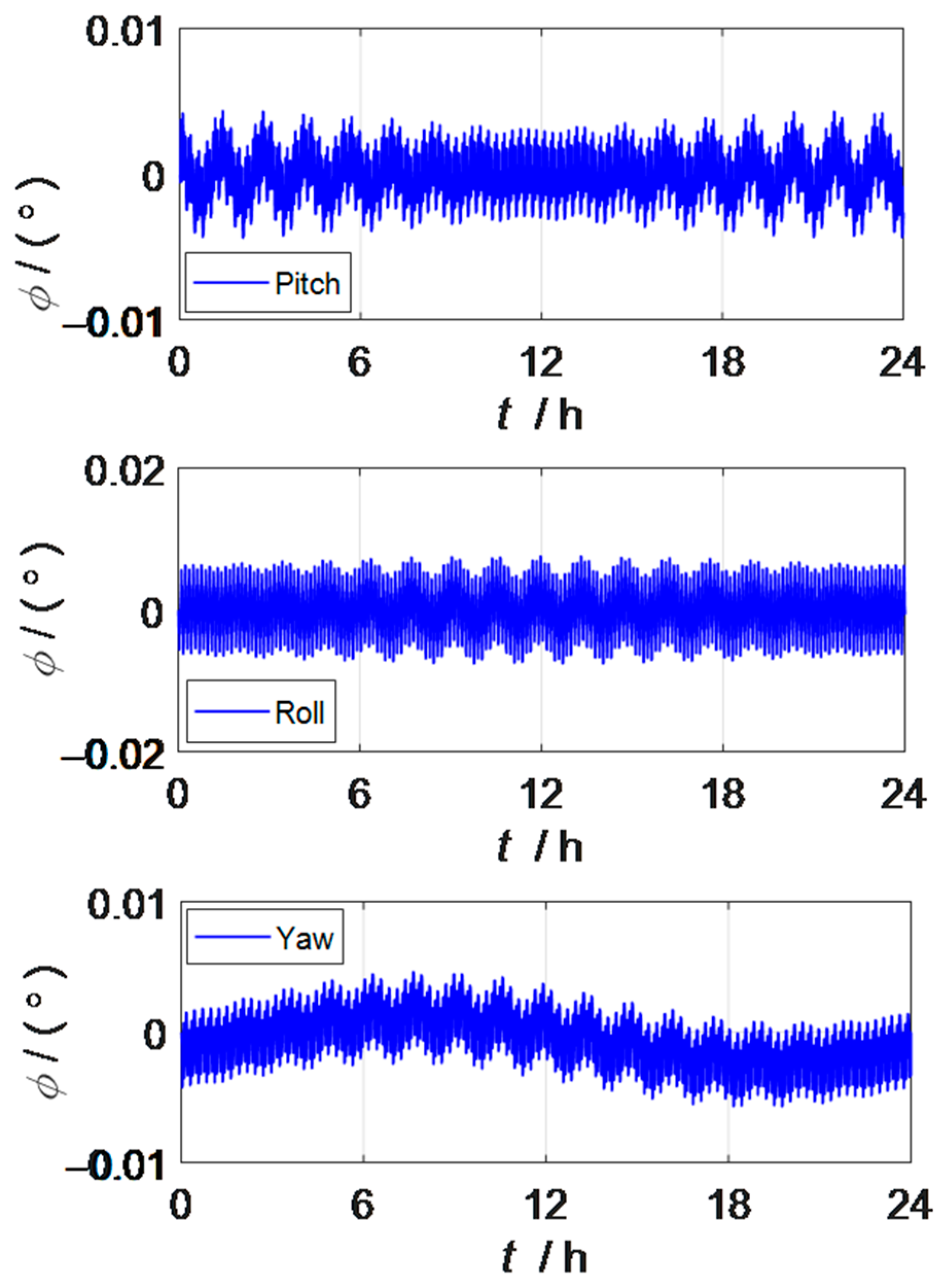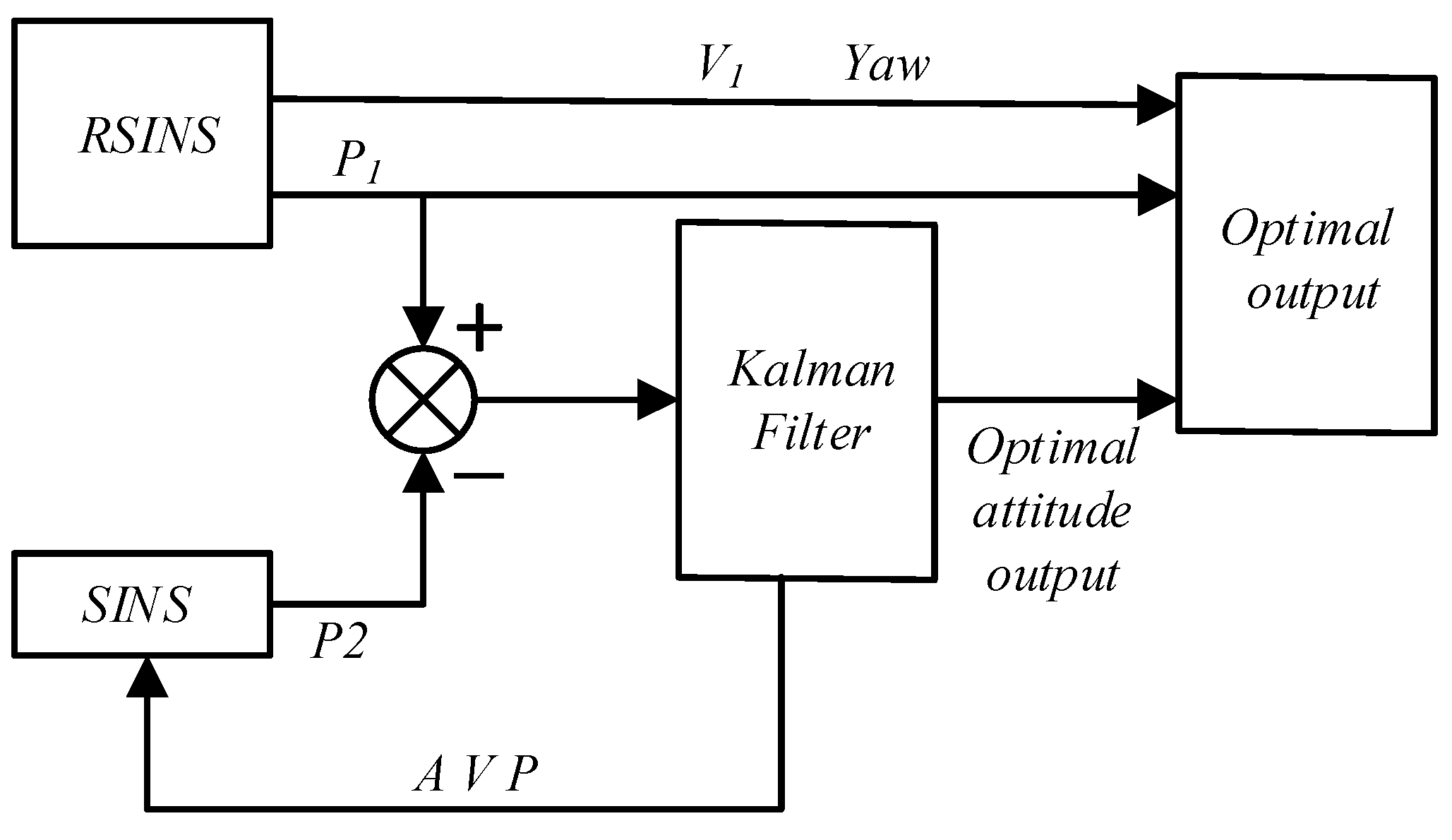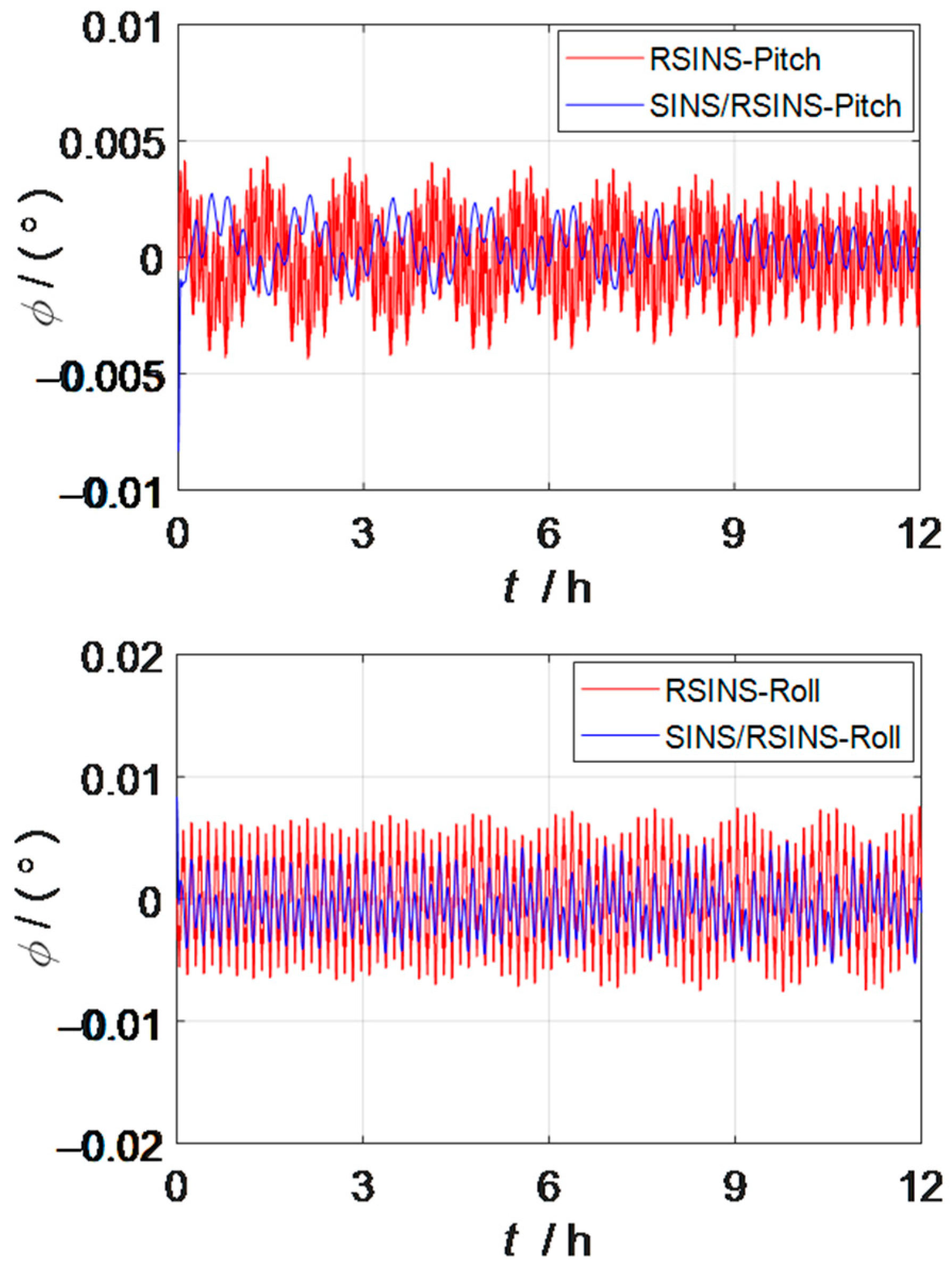A Combination Scheme of Pure Strapdown and Dual-Axis Rotation Inertial Navigation Systems
Abstract
:1. Introduction
2. Error Characterization
2.1. Error Characteristics of SINS
2.2. Error Characteristics of Dual-Axis RSINS
- Constant value error modulation principle
- 2.
- Scale factor error and installation error modulation principle
2.3. Comparison of Error Characteristics of Two INSs
3. Combined Method of Dual Inertial Navigation System
3.1. Dual Inertial Navigation Combination Scheme
3.2. Kalman Filter Design
4. Combined Simulation Verification of Dual INS
4.1. Experimental Conditions
- (1)
- Strapdown inertial navigation system error source: gyroscope constant value error 0.001, random error 0.0003, accelerometer constant value error 10 and random error 1 ;
- (2)
- Rotation strapdown inertial navigation system error sources: gyroscope constant value error 0.001, random error 0.0003, accelerometer constant value error 10 , random error 1 , gyroscope scale factor error 5 , gyroscope installation error 5″, accelerometer scale factor error 10 and accelerometer installation error 10″;
- (3)
- Initial latitude and longitude: 114°, 30°;
- (4)
- Sampling time: 0.1 .
- (1)
- Rotate 180° along the positive Z-axis and stay for 30 s.
- (2)
- Rotate 180° along the negative X-axis and stay for 30 s.
- (3)
- Rotate 180° along the positive X-axis and stay for 30 s.
- (4)
- Rotate 180° along the negative Z-axis and stay for 30 s.
- (5)
- Rotate 180° along the negative X-axis and stay for 30 s.
- (6)
- Rotate 180° along the positive Z-axis and stay for 30 s.
- (7)
- Rotate 180° along the negative Z-axis and stay for 30 s.
- (8)
- Rotate 180° along the positive X-axis and stay for 30 s.
- (9)
- Rotate 180° along the negative Z-axis and stay for 30 s.
- (10)
- Rotate 180° along the positive X-axis and stay for 30 s.
- (11)
- Rotate 180° along the negative X-axis and stay for 30 s.
- (12)
- Rotate 180° along the positive Z-axis and stay for 30 s.
- (13)
- Rotate 180° along the positive X-axis and stay for 30 s.
- (14)
- Rotate 180° along the negative Z-axis and stay for 30 s.
- (15)
- Rotate 180° along the positive Z-axis and stay for 30 s.
- (16)
- Rotate 180° along the negative X-axis and stay for 30 s.
4.2. Experimental Results
5. Conclusions
Author Contributions
Funding
Institutional Review Board Statement
Informed Consent Statement
Data Availability Statement
Conflicts of Interest
References
- Li, K.; Gao, P.Y. Research on self-calibration technique for hybrid inertial navigation system. Chin. J. Sci. Instrum. 2019, 40, 9–17. [Google Scholar] [CrossRef]
- Li, J.; Guo, S.; Cui, G.; Chen, C. Polar underwater calibration for strapdown inertial navigation system. Chin. J. Sci. Instrum. 2018, 39, 51–58. [Google Scholar] [CrossRef]
- Yu, X.D. Research on Some Key Technologies for Single-Axis Rotation Inertial Navigation System with Mechanically Dithered Ring Laser Gyroscope. Ph.D. Thesis, National University of Defense Technology, Changsha, China, 2013. [Google Scholar]
- Zhou, Z.; Wang, X.; Cai, Y. Design Scheme of Optimal Rotation Order for Dual-Axis Rotation Modulation. Aero Weapon. 2020, 27, 81–88. [Google Scholar]
- Titterton, D.H.; Weston, J.L. Strapdown Inertial Navigation Technology; Aerospace & Electronic Systems Magazine IEEE; IET: Washington, DC, USA, 2004. [Google Scholar] [CrossRef]
- Tazartes, D. An historical perspective on inertial navigation systems. In Proceedings of the International Symposium on Inertial Sensors & Systems, Laguna Beach, CA, USA, 25–26 February 2014; IEEE: Piscataway, NJ, USA, 2014. [Google Scholar]
- Qin, Y.-Y. Inertial Navigation; Science Press: Beijing, China, 2006. [Google Scholar]
- Draper, C. Control, navigation and guidance. IEEE Control. Syst. Mag. 1981, 1, 4–17. [Google Scholar] [CrossRef]
- Jiang, Y.; Li, S.; Yan, G.; Xie, B. Carrier navigation information extraction method based on dual-axis rotation modulation inertial measurement. J. Chin. Inert. Technol. 2022, 30, 304–308+315. [Google Scholar] [CrossRef]
- Lv, P.; Lai, J.; Liu, J.; Nie, M. The Compensation Effects of Gyros’ Stochastic Errors in a Rotational Inertial Navigation System. J. Navig. 2014, 67, 1069–1088. [Google Scholar] [CrossRef]
- Xie, Y.; Fan, H.; Wang, Z.; Luo, H.; Yu, X. Optimization design of rotation scheme of dual-axis rotation modulation strapdown inertial navigation system. J. Inert. Technol. 2021, 29, 421–427+436. [Google Scholar]
- Liu, W.; Gao, Y.; Zhao, K.; Sun, W.; Zhou, H. Hull deformation measurement method considering rotational modulation INS shaft angle error. J. Chin. Inert. Technol. 2022, 30, 1–8. [Google Scholar] [CrossRef]
- Zhu, T.; Wang, L.; Wang, Y.; Ren, Y.; Sun, Y. Research on angular motion isolation modulation method of biaxial rotary inertial navigation carrier. Chin. J. Sci. Instrum. 2020, 41, 66–75. [Google Scholar] [CrossRef]
- Sun, M. Research on Error Suppression Technology of Dual-Axis Rotary Modulated Strapdown Inertial Navigation System; Beijing Institute of Technology: Beijing, China, 2018. [Google Scholar]
- Yuan, B.; Liao, D.; Han, S. Error compensation of an optical gyro INS by multi-axis rotation. Meas. Sci. Technol. 2012, 23, 025102. [Google Scholar] [CrossRef]
- Ji, Z.-N.; Liu, C.; Cai, S.-J.; Xu, H.-G.; Zhou, Z.-H. Improved sixteen-sequence rotation scheme for dual-axis SINS. J. Chin. Inert. Technol. 2013, 21, 46–50. [Google Scholar]
- Fan, H.; Xie, Y.; Wang, Z.; Wang, L.; Luo, H.; Yu, X. A unified scheme for rotation modulation and self-calibration of dual-axis rotating SINS. Meas. Sci. Technol. 2021, 32, 115113. [Google Scholar] [CrossRef]
- Liu, W.; Wang, N.; Liu, G.; Nian, H.; Ai, G. A combination navigation method for dual inertial navigation. J. Chin. Inert. Technol. 2014, 22, 1–4+13. [Google Scholar] [CrossRef]
- Liu, W.; Song, G.; Sun, W.; Liu, C.; Wang, N. High-accuracy transfer alignment method of double master INSs to slave INS. J. Chin. Inert. Technol. 2016, 24, 561–564+570. [Google Scholar] [CrossRef]
- Wang, L.; Wu, W.; Wei, G.; Pan, X.; Lian, J. Navigation Information Fusion in a Redundant Marine Rotational Inertial Navigation System Configuration. J. Navig. 2018, 71, 1531–1552. [Google Scholar] [CrossRef]
- Wu, Q.; Li, K. An inertial device biases on-line monitoring method in the applications of two rotational inertial navigation systems redundant configuration. Mech. Syst. Signal Process. 2019, 120, 133–149. [Google Scholar] [CrossRef]
- Cui, J.; Wu, W.; Ma, T.; Wang, M.; Ji, C. Self-correction method for gyro factor error of gyro scale factor of double inertial navigation combined rotational modulation. J. Chin. Inert. Technol. 2022, 30, 561–568. [Google Scholar] [CrossRef]
- Gao, C.; Wei, G.; Wang, Q.; Xiong, Z.; Yang, Z.; Zhou, W.; Liu, W. One-dimensional laser Doppler velocimetry/single-axis rotary inertial navigation combination vehicle elevation measurement method (invited). Infrared Laser Eng. 2022, 51, 9–17. [Google Scholar]
- Zhou, J.; Nie, X.; Lin, J. A novel laser Doppler velocimeter and its integrated navigation system with strapdown inertial navigation. Opt. Laser Technol. 2014, 64, 319–323. [Google Scholar] [CrossRef]
- Zhang, C.; Zhao, X.; Pang, C.; Wang, Y.; Zhang, L.; Feng, B. Improved Fault Detection Method Based on Robust Estimation and Sliding Window Test for INS/GNSS Integration. J. Navig. 2020, 73, 776–796. [Google Scholar] [CrossRef]
- Liu, Y.; Li, S.; Fu, Q.; Liu, Z.; Zhou, Q. Analysis of Kalman Filter Innovation Based GNSS Spoofing Detection Method for INS/GNSS Integrated Navigation System. IEEE Sens. J. 2019, 19, 5167–5178. [Google Scholar] [CrossRef]
- Hu, G.; Gao, B.; Zhong, Y.; Gu, C. Unscented kalman filter with process noise covariance estimation for vehicular ins/gps integration system. Inf. Fusion 2020, 64, 194–204. [Google Scholar] [CrossRef]
- Zha, F.; Chang, L.; He, H. Comprehensive error compensation for dual-axis rotational inertial navigation system. IEEE Sens. J. 2020, 20, 3788–3802. [Google Scholar] [CrossRef]






Disclaimer/Publisher’s Note: The statements, opinions and data contained in all publications are solely those of the individual author(s) and contributor(s) and not of MDPI and/or the editor(s). MDPI and/or the editor(s) disclaim responsibility for any injury to people or property resulting from any ideas, methods, instructions or products referred to in the content. |
© 2023 by the authors. Licensee MDPI, Basel, Switzerland. This article is an open access article distributed under the terms and conditions of the Creative Commons Attribution (CC BY) license (https://creativecommons.org/licenses/by/4.0/).
Share and Cite
He, H.; Zha, F.; Li, F.; Wei, Q. A Combination Scheme of Pure Strapdown and Dual-Axis Rotation Inertial Navigation Systems. Sensors 2023, 23, 3091. https://doi.org/10.3390/s23063091
He H, Zha F, Li F, Wei Q. A Combination Scheme of Pure Strapdown and Dual-Axis Rotation Inertial Navigation Systems. Sensors. 2023; 23(6):3091. https://doi.org/10.3390/s23063091
Chicago/Turabian StyleHe, Hongyang, Feng Zha, Feng Li, and Qiushuo Wei. 2023. "A Combination Scheme of Pure Strapdown and Dual-Axis Rotation Inertial Navigation Systems" Sensors 23, no. 6: 3091. https://doi.org/10.3390/s23063091



